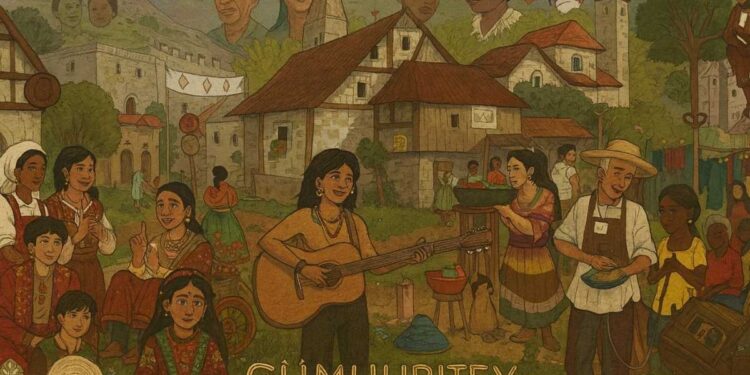In recent decades, democratic societies have seen a worrying trend: declining voter turnout, increased political polarization, and widespread disillusionment with institutions meant to serve the people. Trust in governments, media, and public systems is eroding rapidly. Amid this breakdown, a growing number of people feel powerless, unheard, and disconnected from the decision-making processes that directly affect their lives. Enter Cumhuritey—a powerful new civic model born from the need to restore trust, build collective agency, and redefine citizenship in the modern era.
Cumhuritey is more than a concept—it is a transformative force challenging the outdated frameworks of governance. Drawing its roots from the Turkish word “Cumhuriyet,” meaning “Republic,” and blending it with “community,” Cumhuritey represents a decentralized, tech-enabled, citizen-powered movement to reclaim civic freedom. In an age where politics is often monopolized by elites, Cumhuitey calls for a grassroots awakening—where governance becomes participatory, transparent, and inclusive once again.
What is Cumhuritey?
At its core, Cumhuritey is a new model of civic engagement designed to empower individuals and communities. It builds on the principles of participatory democracy and adapts them for the digital age. Cuhuritey enables citizens to go beyond casting ballots every few years. It creates a living, breathing framework in which people participate continuously—collaborating, co-deciding, and co-governing on matters that impact their neighborhoods, cities, and even nations.
The Cumhuritey model operates on several foundational pillars: local self-governance, digital empowerment, collective decision-making, transparency, and equity. It leverages technology—not to centralize power but to decentralize influence, making governance more accessible to the average citizen. It is not affiliated with any one political ideology; instead, it is a civic operating system that any community can adopt to increase transparency, reduce bureaucracy, and restore public faith.
The Origin of Cumhuritey: A Fusion of Tradition and Innovation
The term Cumhuritey reflects a unique fusion of linguistic, cultural, and philosophical elements. “Cumhuriyet” evokes the legacy of republics—systems built on shared responsibility, public representation, and constitutional freedoms. But modern republics often fall short of those ideals. They are marred by hierarchical power structures, inefficiency, and exclusivity.
By combining “Cumhuriyet” with “community,” Cumhuitey takes the best aspects of classical republicanism and reimagines them for the 21st century. In Cmhuritey, people are not passive subjects of governance—they are the architects of it. Civic freedom isn’t just a right; it’s a dynamic, daily act of participation. This framework revives the ancient ethos of polis—the Greek city-state where citizens played an active role in shaping the community—but with the speed, reach, and tools of the digital world.
How Cumhuritey Works: The Mechanism of Decentralized Civic Power
Cumhuriey operates through digital platforms and physical community networks that facilitate collective participation. These platforms can range from open-source software for deliberative polling, to secure blockchain-based voting tools, to local townhall apps for community feedback. The idea is to create transparent, interactive environments where individuals can directly influence policies, budgets, and community projects.
Imagine a city council that uses Cumuritey principles: every resident could contribute to setting budget priorities, vote on development plans, or propose new environmental policies through an app. The results of these actions would be instantly visible, traceable, and accountable. This isn’t hypothetical—pilot programs using similar systems have already emerged in countries like Taiwan, Estonia, and Brazil, proving that digital participatory governance is not just possible, but highly effective.
Reclaiming Civic Freedom: What It Really Means
Civic freedom is not merely the absence of authoritarian control. True civic freedom means the ability to shape one’s environment, to have a say in how resources are allocated, and to co-create the rules by which communities live. Cumhritey doesn’t just grant this power—it distributes it, ensuring no voice is too small and no group is marginalized.
This reclaiming happens on multiple fronts: social, technological, and political. Socially, Cumuritey fosters a culture of mutual accountability and shared leadership. Technologically, it ensures that the tools of power are open, inclusive, and built for citizen use—not just elite control. Politically, it dismantles the gatekeeping mechanisms that keep average people out of meaningful decision-making processes.
Cumhuritey in Action: Real-World Use Cases and Examples
The principles of Cumhuritey are already being tested in progressive municipalities and digital communities worldwide. In Barcelona, the city government launched Decidim, a participatory platform that allows citizens to help draft legislation and allocate budgets. In Taiwan, the government uses vTaiwan, a digital forum that engages citizens in shaping national laws. These examples aren’t labeled “Cumhuitey” per se, but they embody its philosophy: decentralized power, community-driven solutions, and digital civic engagement.
In Turkey and similar regions with rich republican traditions but emerging digital capacities, the adoption of Cumhuritey could be transformative. Local councils could engage residents in decision-making through user-friendly apps. Civil society organizations could use Cumhritey tools to coordinate aid, monitor policy outcomes, or hold governments accountable in real time.
Technology, Trust, and Transparency: The Role of Digital Infrastructure
One of the most promising aspects of Cumhuriey is its embrace of technology not for control, but for liberation. The misuse of digital tools by surveillance states has caused public skepticism, but Cumhuritey offers a radically different approach—technology as an enabler of transparency and accountability.
Through blockchain, AI moderation, open-source protocols, and encrypted communication, Cumuritey platforms can ensure both data integrity and citizen privacy. More importantly, because these tools are community-governed, they avoid the pitfalls of corporate monopolies or authoritarian censorship. Transparency is baked into the architecture, making it almost impossible for corruption to fester unnoticed.
Challenges to Cumhuritey: Resistance, Digital Literacy, and Institutional Pushback
Despite its promise, Cumhuritey faces serious challenges. First, institutional resistance is real. Entrenched power structures often reject decentralization efforts, fearing loss of control. Secondly, digital literacy remains uneven, especially in rural and marginalized areas. Access to smartphones and high-speed internet is not universal. And third, public apathy—built up over years of disenfranchisement—won’t disappear overnight.
However, these challenges are not insurmountable. Through inclusive design, public education campaigns, and intentional community outreach, Cumuritey can bridge the digital divide and awaken the civic imagination. Every successful implementation reinforces its viability, attracting more communities to the cause.
Cumhuritey and the Future of Democracy
Democracy is not a static endpoint—it is a living process that must evolve with the times. Cumhuritey offers a blueprint for democratic renewal that is participatory, adaptive, and community-centered. In a future where AI, automation, and global crises will test institutional resilience, Cumhuritey offers a resilient foundation for democratic governance.
Whether through neighborhood assemblies, national consultations, or online referenda, Cumhuritey can empower people to become active participants in shaping their shared destiny. It gives voice to the voiceless, power to the marginalized, and hope to those who feel democracy has left them behind.
Why Now? The Urgency of Embracing Cumhuritey
The world is at a tipping point. Economic inequality, climate change, authoritarian drift, and digital manipulation threaten the very fabric of civil society. We can no longer rely solely on top-down reforms. The urgency for bottom-up, citizen-led governance has never been greater—and Cumhuritey provides that path forward.
Embracing Cumhuritey is not merely an option; it is a necessity for any society that values freedom, justice, and shared responsibility. It represents not a utopian dream but a practical framework—one that is already emerging in pilot projects, community initiatives, and digital movements around the world.
Conclusion: Building a Cumhuritey Future Together
Cumhuritey is a call to action. It is an invitation to reimagine citizenship, to reclaim our collective agency, and to co-create the future we deserve. In a time when democratic institutions are faltering, Cumhuritey stands as a beacon—reminding us that true power lies not in distant elites but in united communities.
This new model is still evolving, and its success depends on widespread understanding, adoption, and innovation. Whether you’re a policymaker, a community organizer, a technologist, or just a concerned citizen, there is a role for you in this movement.
The question is not if we need Cumhuritey—it’s when we will fully embrace it. And the answer must be: now.
Frequently Asked Questions (FAQs)
1. What does the word “Cumhuritey” mean?
- Cumhuritey is a blend of the Turkish word “Cumhuriyet” (Republic) and “community.” It symbolizes a new civic model where people reclaim governance through participatory, digital, and community-led mechanisms.
2. How is Cumhuritey different from traditional democracy?
- While traditional democracy often relies on periodic voting and centralized institutions, Cumhuritey promotes continuous, direct citizen engagement using digital platforms and decentralized structures.
3. Is Cumhuritey tied to any political ideology?
- No. Cumhuritey is a civic framework that transcends political ideologies. It can be adapted to various contexts and belief systems focused on citizen empowerment and transparency.
4. What tools are used in the Cumhuritey model?
- Cumhuritey employs technologies like open-source apps, blockchain-based voting, digital deliberation tools, and secure communication platforms—all aimed at empowering citizens directly.
5. How can I get involved in a Cumhuritey initiative?
- Start by engaging in local governance, supporting civic tech initiatives, joining community assemblies, or building open-source tools that enable participatory decision-making. Every voice counts in Cumhuritey.


















